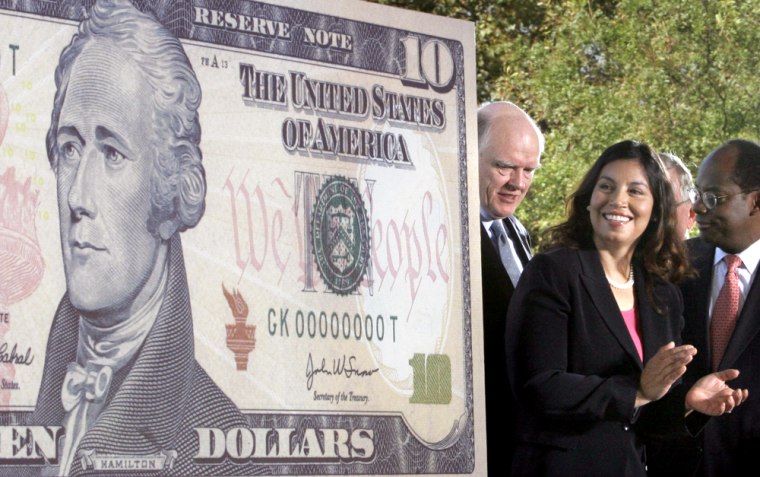Hooray for the red, yellow and orange! Those are the colors featured on the newly redesigned $10 bill, the third currency denomination to add splashes of color to the traditional green of U.S. currency.
Some 800 million of the new bills will be put into circulation starting early next year in the government’s latest effort to stay ahead of tech-savvy counterfeiters.
“The craftsmanship that goes into our currency is unmatched anywhere in the world. So is our commitment to safeguarding that currency,” said Treasury Secretary John Snow, who participated in an unveiling ceremony on Ellis Island in the New York harbor.
The location was selected to highlight one of the bill’s new features — a red image of the Statue of Liberty’s torch on the left side of a revised portrait of Alexander Hamilton, the first secretary of the Treasury, who is shown without the traditional oval frame around his portrait.
Also highlighted in red is the phrase from the Constitution “We the People” on the right side of Hamilton’s portrait. The bill overall has a subtle orange background. The yellow is seen in small 10s around the torch on the front of the bill. There are also small yellow 10s to the right of the U.S. Treasury building, which remains on the back of the bill.
The makeover of the $10 bill follows similar colorization of the $20 bill in 2003 and the $50 bill last year.
Plans call for the $100 bill to be redesigned in 2007, a rollout delayed so more security features can be added to the favorite denomination of counterfeiters outside the United States. There are no plans to change the $1, $2 and $5 bills.
Other security features of the $10 bill, which were introduced in an earlier makeover, include a plastic security thread that repeats “USA Ten” in tiny print. There is also a watermark that can be seen when the bill is held up to the light, and color-shifting ink that makes the numeral “10” to the right of Hamilton change color from copper to green when the bill is tilted.
Each bill denomination has different colors mixed in with the traditional green. For the $20, the additional colors were peach and blue while the $50 bill has blue and red.
Thomas A. Ferguson, the director of the Bureau of Engraving and Printing, which produces all U.S. paper money, said the government plans to redesign the currency every seven to 10 years to keep ahead of counterfeiters armed with ever more sophisticated devices.
Since 1995, digitally produced counterfeit notes have increased from less than 1 percent of those detected in the United States to about 54 percent.
